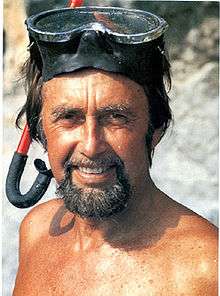Jacques Mayol
Jacques Mayol (April 1, 1927 – December 22, 2001) was the holder of many world records in free diving.[1]
Jacques Mayol was a French national born in Shanghai, China. He was the first free diver to descend to 100 meters (330 ft) (November 23, 1976), and he managed to descend to 105 meters when he was 56 years old. During the scientific research phase of his career, he tried to answer the question of whether man had a hidden aquatic potential that could be evoked by rigorous physiological and psychological training.
The film The Big Blue, directed by Luc Besson in 1988, was inspired by his life story (and the life story of the Italian diver Enzo Maiorca); Mayol was one of the screenwriters.
On December 22, 2001, Mayol committed suicide by hanging himself in Elba, Italy, at the age of 74. His ashes were spread over the Tuscany coast.[1]
Free diving
Jacques Mayol’s lifelong passion for diving was based on his love for the ocean, his personal philosophy and his desire to explore his own limits. During his lifetime, he helped introduce the, until then, elitist sport of free-diving into the mainstream. His diving philosophy was to reach a state of mind based on relaxation and Yoga, with which he could accomplish Apnea.[2] He also contributed to technological advances in the field of free-diving, particularly improving assemblies used by no-limits divers. He was also instrumental in the development of scuba diving's octopus regulator, which was invented by Dave Woodward at UNEXSO around 1965-6. Woodward believed that having the safety divers carry two second stages would be a safer and more practical approach than buddy breathing in the event of an emergency.[3]
Mayol was already an experienced free diver when he met the Sicilian Enzo Maiorca who was the first to dive below 50m. Mayol reached 60m depth.[4] A friendship, as well as rivalry between the two men ensued. Their most famous records were set in the no-limits category, in which the divers are permitted to use weighted sleds to descend and air balloons for a speedy ascent. Between 1966 and 1983, Mayol was eight times no-limits world champion. In 1981 he set a world record of 61m in the constant weight discipline, using fins. In 1976 Mayol broke the 100m barrier with a no-limits 101m dive off Elba, Italy.[4] Tests showed that during this dive his heart beat decreased from 60 to 27 beats/min, an aspect of the mammalian diving reflex, a reflex more evident in whales, seals, and dolphins. Mayol’s last deep dive followed in 1983 when he reached the depth of 105m, at the age of 56.[4]
Dolphins
Mayol’s fascination with dolphins started in 1955 when he was working as a commercial diver at an aquarium in Miami, Florida.[4] There he met a female dolphin called Clown and formed a close bond with her. Imitating Clown, he learned how to hold his breath longer and how to behave and integrate himself underwater. It is the dolphins that became the foundation of Mayol’s life philosophy of Homo Delphinus.[2]
Throughout his book L'Homo Delphinus[2] (2000 published in English as Homo Delphinus: The Dolphin within Man by Idelson Gnocchi Publishers Ltd.) Mayol expounds his theories about man’s relationship with the sea: Does man really have an aquatic origin? How can man re-awaken his dormant mental and spiritual faculties and the physiological mechanisms from the depths of his psyche and genetic make-up to develop the potential of his aquatic origins, to become a Homo delphinus?
Jacques Mayol predicted that, within a couple of generations, some people would be able to dive to 200 m and hold their breath for up to ten minutes. Today the no-limits record stands at 253 m (Herbert Nitsch, June 2012). Serbian Branko Petrović holds the record for Static Apnea at 11 minutes and 54 seconds (October 2014).[5] Croatian Goran Čolak holds the record for static apnea on pure oxygen at 23 minutes 1 second (June 2014).[6]
References
- 1 2 "Diving legend commits suicide". BBC News. 2001-12-24. Retrieved 7 May 2010.
- 1 2 3 http://www.apnea.nl/UK-Index.htm
- ↑ http://www.internationallegendsofdiving.com/FeaturedLegends/woodward_bio.htm
- 1 2 3 4 http://www.thejacquesmayol.com/JacquesMayol.htm
- ↑ https://www.deeperblue.com/new-guinness-world-record-serbian-freediver-branko-petrovic/
- ↑ http://www.croatiaweek.com/goran-colak-sets-new-guinness-record-after-23-minutes-underwater/
External links
- Biography from thejacquesmayol.com
- Current Freediving World Records
- Profile from Historical Diving Association website
- Article from divernet.com
- Obituary from BBC
- Obituary from The Independent (2013-04-14 Gone, copy at the Wayback Machine (archived September 26, 2011))
- (French) Article by Le Monde
